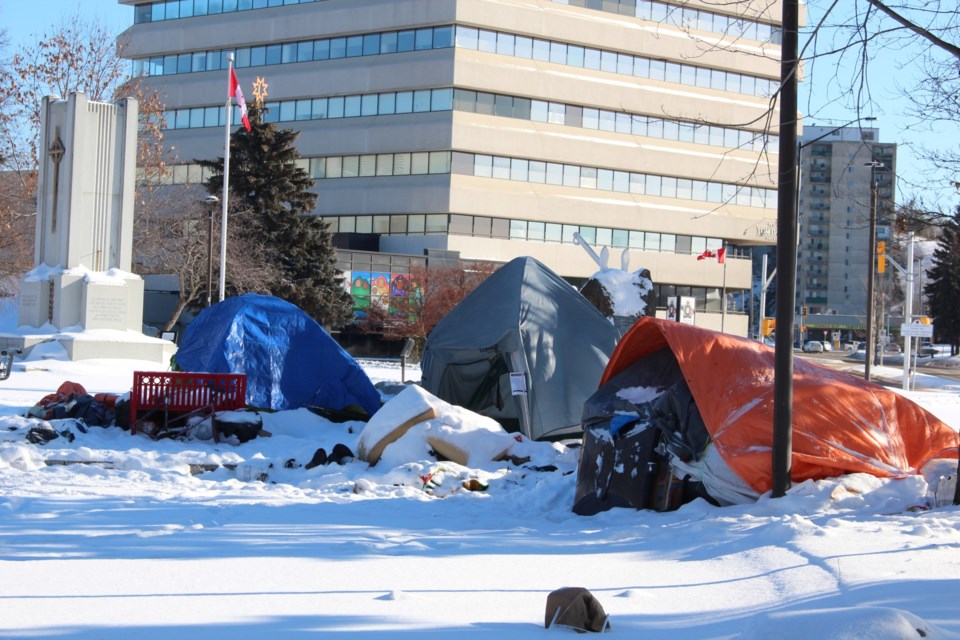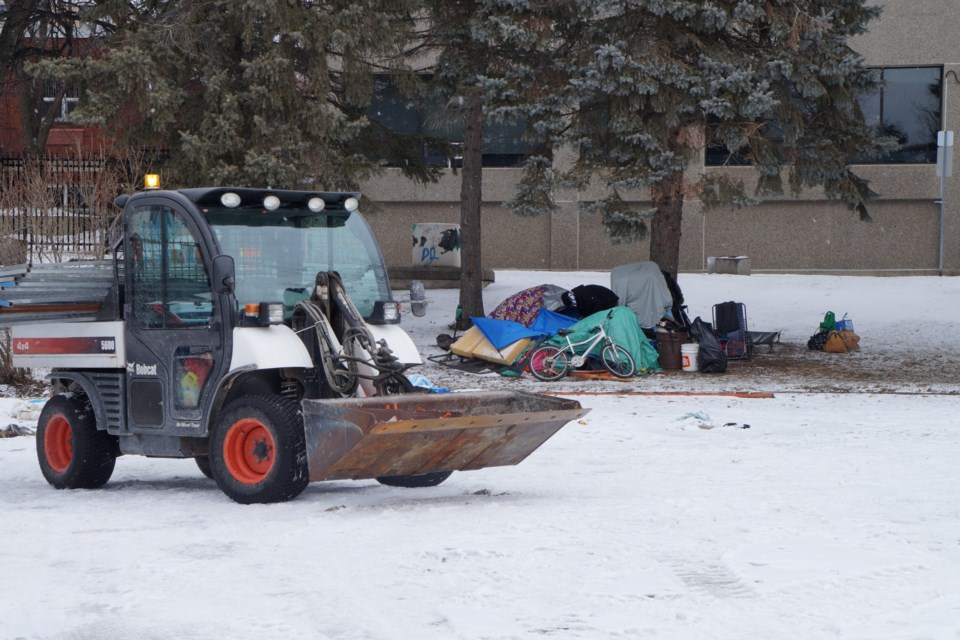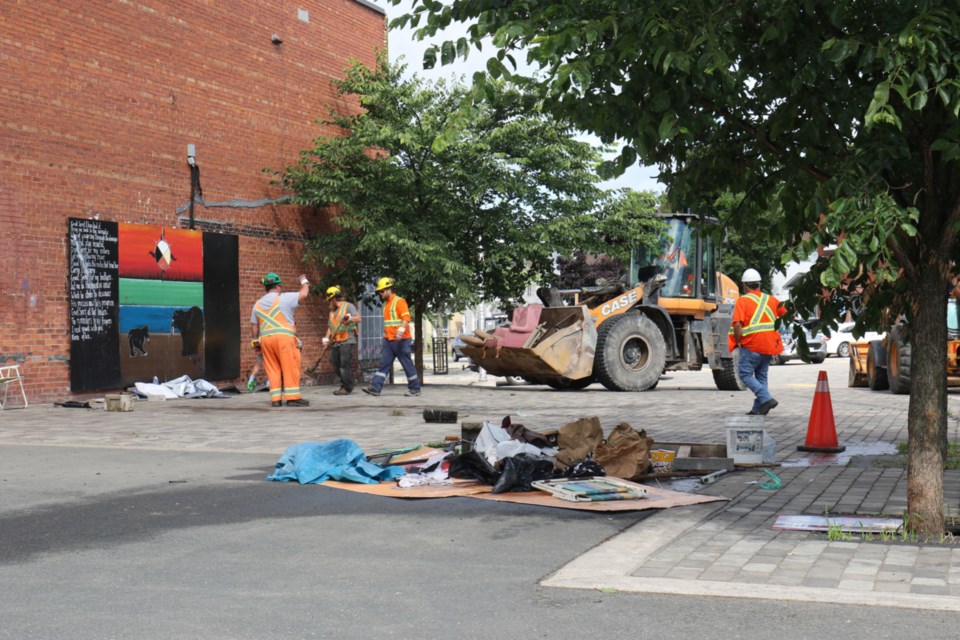Small strings of battery-powered lights encircle a vine, brought from the outside in as a houseplant of sorts, decorating the pitch of the large tent where 15 people sleep in a space meant for five. A shelf alongside a thin nylon wall holds a pink-sparkled journal and pen, a loaf of bread, a can of soup and a small pot. A broom sits in the corner, alongside a wash bin.
The tent’s owner, a thin woman with long, black hair and a beautiful smile, offers a tour, introducing her “street family” as they lie in their makeshift beds with thin wool blankets. The woman smudges the corners of the tent, and each person who enters, with burning sage, the embers snapping and sparking in the dark.
Directly outside, in plain view, is Sudbury’s City Hall — and more tarps and tents, each one a stark reminder of the dichotomy of life in modern capitalist democracies: overwhelming prosperity for some, abject poverty for many.
Sadly, encampments like this have become all too common in cities and towns across the province since the onset of COVID-19, the most visible symptom of Ontario’s epidemic within the pandemic: homelessness. But while attention is often fixed on southern Ontario, the wounds grew and festered up north, with rates of homelessness now almost double that of some southern municipalities.
Mandated vulnerable population counts show that Sault Ste. Marie and the districts of Kenora, Nipissing, and Cochrane are overwhelmed with significantly higher per capita populations of unhoused people than cities such as London, Hamilton, Ottawa or Toronto. At the same time, the opioid crisis has hit northern Ontario especially hard. For much of the pandemic, Sudbury had the highest rate of fatal drug poisonings in the province. That dubious distinction now belongs to Thunder Bay, with Algoma District, which includes the Sault, coming in at third.

Homelessness and the overdose crisis had already begun to rip through the North before the pandemic, in part because of stagnant income supplements like Ontario Works (OW) and the Ontario Disability Support Program (ODSP), the rising cost of living and a dearth of health-care services. And thanks to the unholy trinity of intergenerational trauma, poor living conditions and lack of access to services, the crisis disproportionately impacts the Indigenous population of the North.
Then came COVID-19, which forced service closures and capacity limitations for resources already stretched to cover those who migrated to the cities from remote communities, or moved from southern Ontario to the North, believing there would be more services and shorter waitlists — a holdover of long-held misconceptions. In fact, 72 per cent of those surveyed during Sudbury’s vulnerable population count were from another area.
The people of northern Ontario responded by demanding municipalities to act — to do something about the number of tents multiplying in plain sight. In the beginning, many cities chose the same law enforcement-based response as Toronto did. In Sudbury, for example, the Memorial Park encampment was eventually torn down last April.
More recently, however, cities have turned away from a heavy-handed approach to more gentle initiatives: increasing shelter spaces, providing acute housing outreach, opening warming centres and, in one case, renting out a college residence. A recent Ontario Superior Court ruling will make it even harder for municipalities to remove encampments: the judge concluded it could be unconstitutional to prohibit someone from erecting a tent if appropriate shelter options are not available.
The homelessness issue was always prevalent, but once the pandemic hit, just the closure of services, the unavailability of access to basic services, just really brought everything to the surface.
But while tents strewn about municipal grounds are a visual reminder of people in need, it is far from the source of that need. That’s why the district service managers of northern Ontario are calling for support not only to house people, but to help keep them housed for the long term. They’re pushing for housing that comes with support for addictions, mental health issues and cultural trauma; or at the very least, more patience for those who may never have learned to manage housing. It’s time, they say, to focus not just on housing vulnerable populations, but also on keeping them alive.
Because make no mistake, people are dying.

Surrounding each major municipality in northern Ontario is a series of smaller communities; these towns and First Nations make up a district. Each district’s housing and homelessness response is handled by a District Social Services Administration Board (DSSAB), or in the case of City of Greater Sudbury, a consolidated service manager (CSM). They are all known as “service managers.”
Village Media interviewed the service managers in every northern district: Sudbury, Nipissing (North Bay), Sault Ste Marie, Cochrane (Timmins) and Thunder Bay. All of them agreed that homelessness has long been a struggle across their communities — but that the arrival of COVID-19 made the situation far worse, bringing tents to the manicured lawns of City Hall.
“The homelessness issue was always prevalent,” says Mike Nadeau, CEO of the District of Sault Ste Marie’s Social Services Administration Board. “But once the pandemic hit, just the closure of services, the unavailability of access to basic services, just really brought everything to the surface.”
All the service managers represent hub cities: large population centres like Sudbury, where social and other services are often centralized. This centralization leads to a perception that these hub cities have more social services available for people who need them, a situation that leads to two scenarios: people who are homeless will travel to and congregate in communities where they can access services; and social service providers in smaller communities will often put people on buses with a one-way ticket to a larger community, again thanks to the perception more services will be available.
And while it is true there are more services available in hub cities, those services are barely sufficient as it is, Village Media was told. Social housing is certainly offered in the hub cities, but it is made for those who are able to live independently, something that is a struggle for many people on the street who are often fighting addiction, mental illness and a lifetime of trauma that has left them unprepared for the more regimented existence of life off the street.
That is the heart of it, the service managers say. This isn’t so much a housing crisis as it is a health-care crisis. Homelessness is the symptom, not the sickness. The lack of mental health and addictions support is the sickness.

Data is the standard for decision-making, particularly when it comes to government funding. With a majority of flow-through funding from upper levels for social services based on historic spending, funding envelopes have not kept pace with the sudden and extreme rise in homelessness that appeared over the pandemic.
Besides historic spending, funding is also based on currently available data. But that, too, seems to be lacking, thanks in part to how that data is gathered. It depends on what are called Point-in-Time counts, or PiT counts. This is the number of homeless people in a given area during a given timeframe, providing a snapshot of the situation on the ground.
While instructive, PiT counts are not the most robust way of data-gathering, officials told Village Media. A PiT count tallies people who are homeless, either sheltered or unsheltered, and who consent to be part of the count. It is performed over a 24-hour period and, as its name suggests, is intended to capture demographics at a single “point in time.”
The count is undertaken every two years and since 2018, has been mandated under Section 19.1 of the Housing Services Act. The count is essentially a snapshot of the vulnerable population in any area, and this, its critics say, is the big flaw in its methodology.
“They are just a point in time,” said Bill Bradica, CEO of the District of Thunder Bay Social Services Administration Board. “It depends on the weather, it's a one-off thing, you're not going to capture every single person who's homeless or at risk of being homeless.”
Vulnerable populations can and often do avoid authority figures — even trusted outreach workers — or wish to remain anonymous. Numbers can be inconsistent due to the often transient nature of those who are homeless, with actual homelessness changing from day to day.
PiT counts are not performed in smaller towns due to a lack of resources needed to cover an enormous territory during a 24-hour counting period. The District of Cochrane, for instance, includes 11 other municipalities along the Highway 11 Corridor, as well as the town of Moosonee. The territory is 141,268 square kilometres, slightly smaller than Michigan and the second largest district in Ontario.
Despite its limitations, PiT counts do provide a snapshot of information. According to the counts from 2021, per capita (compared per 1,000 people), Sault Ste. Marie (3.0) and the districts of Kenora (3.1), Nipissing (3.5), and Cochrane (3.9) have higher homeless populations than some of the largest municipalities in Ontario, including Toronto (2.5).
Greater Sudbury’s PiT count was 2.4 per 1,000, exceeding the City of Ottawa (1.3) the City of Hamilton (1.7) and the Region of Waterloo (1.8).
Officials say a disproportionate number of people living on the street in northern Ontario identify as Indigenous. Mike Nadeau says that in Sault Ste. Marie specifically, approximately 12 to 16 per cent of the population identify as Indigenous, but among the homeless population, 65 per cent identify as Indigenous.
“That should be statistically impossible to achieve,” says Nadeau. He believes that stat is surely influenced by what he calls “past colonial practices, opinions and attitudes.”
That, and the state of housing within northern First Nation communities. “There's inadequacy of proper housing in many First Nation communities, through no fault of their own, so people have to leave their community and they often have to do so without that social fabric, without that safety net,” Nadeau says. “And, unfortunately, they'll end up homeless or facing an addiction.”

To Brian Marks, CAO of Cochrane’s District Social Services Administration Board, the homelessness issue is much deeper than “a lack of housing.” It’s an addictions crisis with no end in sight.
“It's the lack of mental health and addiction support that are keeping people homeless,” Marks says. “And without those supports, people will fail. We need supportive housing and not just housing if we're really going to make a difference in this.”
Every hub city in the North has a higher average opioid mortality rate than the provincial average. From January 2021 to December 2021, 101 residents of the Sudbury and Manitoulin districts died from an opioid-related overdose; from January to July of this year, 77 people in the district died of overdose. The mortality rate in Thunder Bay is even higher, where 152 people died in 2021.
Opioid-related deaths among people experiencing homelessness increased by 139 per cent during the pandemic.
Substance use is often attributed to pain and mental illness. In northern Ontario, those challenges are often paired with the trauma experienced by much of the Indigenous population: poor conditions on reserves, addiction, residential school trauma and hopelessness.
According to the Canadian Centre on Substance Use and Addiction, approximately 21 per cent of the nation's population (about six million people) will experience a substance-use disorder or addiction at some point in their lifetime, including alcohol and gambling.
A report from the Centre for Addiction and Mental Health found people with a mental illness are twice as likely to have a substance-use disorder compared to the general population. At least 20 per cent of people with a mental illness have a co-occurring substance-use disorder. For people with schizophrenia, the number may be as high as 50 per cent.
Similarly, people with substance-use disorders are up to three times more likely to have a mental illness. More than 15 per cent of people with a substance-use disorder have a co-occurring mental illness.
Recovery and mental health programs in Ontario are costly, with wait times verging on months or even years. What’s more, access to services can vary by region, with many in northern Ontario having to travel hundreds of kilometres to receive care.
It’s a systemic issue that not only costs lives, it costs money. That same report continues to note mental illness and substance-use disorders account for between 11 and 15 per cent of Ontario’s “disease burden” — meaning the impact of a health problem as measured by, in this case, financial cost. However, those disorders only receive about seven per cent of health-care dollars. Those costs are often taken up by other ministries or the federal government.
The Canadian Mental Health Agency’s State of Homelessness reports the annual cost of homelessness to the Canadian economy is $7.05 billion. The annual economic cost of opioid use in Canada is $3.5 billion. This includes costs related to increased spending needs for health care and criminal justice, and costs linked to “lost productivity.” Unemployment rates are as high as 70 to 90 per cent for people with the most severe mental illnesses, thereby increasing the need for income supplements.
There is also a housing “domino effect,” say the service managers. With the very limited supply of community housing (formerly called social housing), people with mental health and addictions issues — those who need round the clock care for everything from life skills to harm reduction and addiction management — are often living in spaces designed for seniors and low-income families.
The costs continue to increase, the death toll rises, and all the while, more people are becoming addicted and the system has no way to manage or pay for it.

The “supportive” aspects of supportive housing aren’t something municipalities are tasked with, funded for, or trained to manage. The answer, officials told Village Media, is supportive housing with provincially funded care available to the residents.
“That's the health system, that's where the province needs to step in, and the federal government and the local health systems and making sure that they're providing those supports, whether it be 24/7, or two hours a day, whatever individuals need,” Nadeau says.
He acknowledged that maintaining community housing is a challenge, but not an insurmountable one. The problem for social service boards is simply a lack of resources. Nadeau says that expecting the boards to maintain community housing while also funding costly supportive housing services (which are additional services aimed at helping the newly housed stay in their homes by offering life skills training, counseling and other services), is wholly unrealistic.
“That's where the model falls apart,” he says. “I've always told the ministers and I’ve told the province, every time we have an audience, it's a three-legged stool: You need the capital investment, you need the rent subsidy, and you need the support.”
Support has been at the centre of Finland’s housing first policies since the mid-1980s, when that country’s homelessness crisis began. And while Finland is not dealing with the same level of substance abuse issues as northern Ontario, there is potential in their model — not only in the community-focused assisted living facilities, but in the way the country’s policies use a carrot-and-stick methodology.
When housing developers are creating new housing units, municipalities in Finland will offer a carrot: they will manage the rent and administration of any building offered to them and then work with local community partners to offer mental health and medical support. The stick? If developers do not make the change, the city will no longer buy services from them, as the city is committed to making the change to a housing first model.
In Finland, there are clear supportive housing measures, funded and encouraged by the government.
What also needs to come from the provincial government, said the service managers, is more funding for health care, with a focus on mental health and addictions care. They say that will not only prevent the deaths of more people in northern Ontario, but could come close to solving, or at least managing, the homelessness crisis.
Housing needs to be a part of the community, an idea at the heart of Finland’s success, and needs to involve all members of the community. It also needs to surround a vulnerable person with care customized for their needs and their culture. If not, homelessness will continue to be an unending cycle for many, says Bradica of Thunder Bay.
“People will simply cycle in and out of emergency shelters, the hospital, the criminal justice system and sleeping rough if there aren't proper spaces and supports to help them to survive to break that cycle,” he says. “And it is an investment, not only in money, but in time and patience. But it’s critical, it’s critical. Otherwise, this cycle will just continue.”
Jenny Lamothe is a reporter with Sudbury.com. She specializes in covering the diverse communities of her city, especially people who are vulnerable or marginalized.


